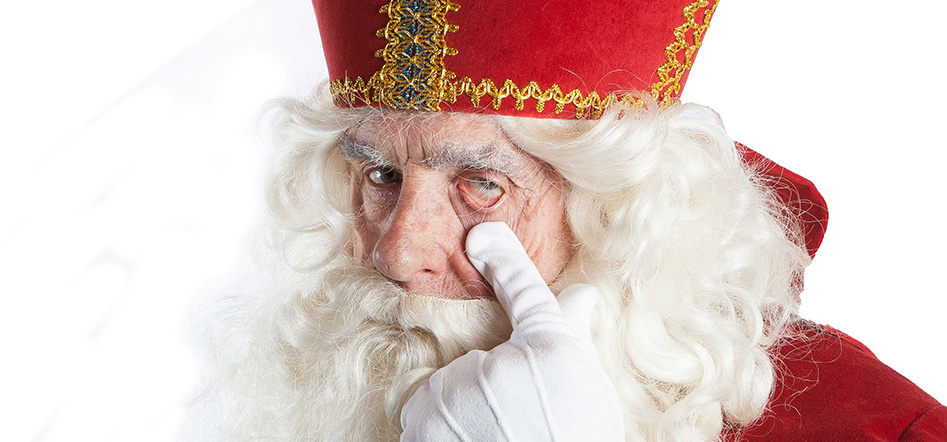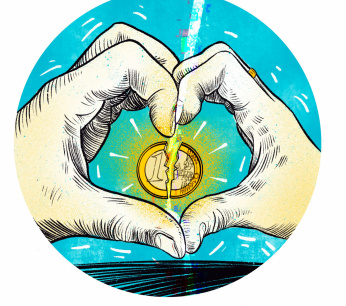Sinterklaas is a lie
When the truth about Sinterklaas is revealed, it turns out that everyone lied: from Dieuwertje Blok to the teacher. “Don't make it heavier than it is. The party is still there. ”

Picture: Type tank
Believing in Sinterklaas is not very different from believing in Hansel and Gretel. The difference is that actually all adults participate in the plot of Sinterklaas, and that about Hansel and Gretel it is easy to say: No dude, they do not exist at all, there are certainly no parents who leave their children in the woods.
Young children have a hard time separating fantasy and reality. “This so-called magical thinking occurs in children between the ages of three and six and then diminishes,” says Chariva Zaandam, who wrote the children's book Sinterklaas for older children. "When a child is about seven years old, it starts to wonder: How is it possible that Sinterklaas is in so many places at the same time?"
Questions
“The Saint on television looks different from the one in the village. The clothes, the voice: everything is different ”, adds child and parenting coach Tea Adema. “A child becomes more perceptive. For example, it picks up signals about presents. When my daughter was three, I could safely do Santa Claus shopping with her there. She did not make the link between the groceries and the presents in the bag. With a seven-year-old child, you really don't have to give that any more. ”
When a child is about seven years old, it starts to wonder: How is it possible that Sinterklaas is in so many places at the same time?
When faith falters, questions come. “I always say: I think he exists, I see him so often on TV”, says teacher Nathalie van Thiel, author of the book 101 questions to the teacher. “When children discover that there are different Santa Clauses, I recognize that. There are real ones and there are fakes, I say. 'But you have to have respect for all Santa Claus, because there could just be one of them the real one.' ”
Task
Van Thiel is clear: telling that Sinterkaas does not exist is not the teacher's task. Chariva Zaandam has the same view. “It has no educational value for the school. When the teacher does get questions about it, he must creatively avoid the answer and refer to parents. ”
“I would answer the question with a question in return,” says child coach Adema. "What do you think? Let the child figure out for themselves whether or not Sinterklaas exists. Grant him that process, sometimes it takes weeks before he is ready to acknowledge that Sinterklaas does not exist. ”
Disappointment
The truth can be a disappointment or even something to get angry about. After all, children have been lied to, even by those they trust most. “Why would adults arrange it like that? I would ask a student who is angry or disappointed,” says Adema. “You can explain the wonderful party that adults give children. And tell that children can hand out presents themselves when they grow up. The party will then shine in a new way. ”
Jan Ligthart, one of the Netherlands' best-known pedagogues, turned himself in 1907 in the magazine School en leven against the Sinterklaas myth. He was concerned about the blow to children when they discover that Sinterklaas does not exist. He also found it strange that educators use a fictional character to get their child under control ('If you don't tidy up your room, Sinterklaas might skip you this year'). But perhaps the worst thing to Ligthart was that a 'so-called childhood friend' was much better off wealthy children than 'the poor in their slums'.
In 1938, another well-known educator, Dirk Leonardus Daalder, editor-in-chief of The Child magazine, researched the Sinterklaas myth. He interviewed 209 students. Last year, this survey was repeated among 127 young people by scientists and students of the University of Groningen. Just like in 1938, children were seven to eight years old when they discover that Sinterklaas does not exist. What is striking about the repeated research is that children today are more reliant on the fact that Sinterklaas does not exist than children in 1938: 57 percent experience disappointment, emptiness, sadness and loss. In 1938 this was 39 percent. “This is probably because children today are raised much more protectively,” explains Groningen educational historian and emeritus professor of gender studies Mineke van Essen. “Children today are less used to disappointments. In the XNUMXs they took things much more as they came. Today's emotional culture was not there yet. ”
What is striking about the repeated research is that children nowadays rely more heavily on the fact that Sinterklaas does not exist than children in 1938.
Moreover, in the 1915s, Sinterklaas was much more than someone to fear today. Anyone who was naughty got the roe, or was taken to Spain by boat. In the XNUMX booklet Mee in den zak, dozens of naughty children hung with bags and all in the hold of the Sinterklaas boat. Van Essen: “Children were more relieved than now that that scary Sinterklaas did not exist.”
Play
The feeling of disappointment prompted Chariva Zaandam to make a book 'for big children' about Sinterklaas. “In conversation with friends I found out that they all still knew when they discovered that Sinterklaas did not exist. And that was not a nice memory for anyone. That must be possible, I thought. So I wrote a book in which children are taken into the history of Sinterklaas and are made part of it in secret. The book tries to turn the revelation of the secret from a disappointment to something that children can be proud of: I have unraveled the secret and can now play the play myself. ”
“You shouldn't make it heavier than it is,” says child coach Adema. “As an adult you really don't have to express regrets or anything like that. No, the child is now one of the greats, can be Sinterklaas himself. It is the beginning of a new phase of life. ”
If a child in group 6 still believes, it is time for a serious talk with parents. There is probably more going on with the development of that child.
Believing or disbelieving in the holy man approaches Adema as a signal that tells something significant about the development of a child. “If a child in group 6 still believes, it is time for a serious conversation with parents. There is probably more to the development of that child. Is he still brought into class every day or he cannot yet eat independently. That child must then become more autonomous. ”
Help-Sint
In almost all schools, Sinterklaas comes to celebrate his birthday in the first four groups in the classroom. In the higher classes he also comes by, but the children often draw lots, while some children in group 5 still believe. “It is best to explain to children that the Saint simply does not have time to buy presents for all children and that they must therefore act as a help Saint,” says teacher Nathalie van Thiel, who has stood for group 5 for years. "This way you can have a party that is fun for both children who believe and those who do not believe."


